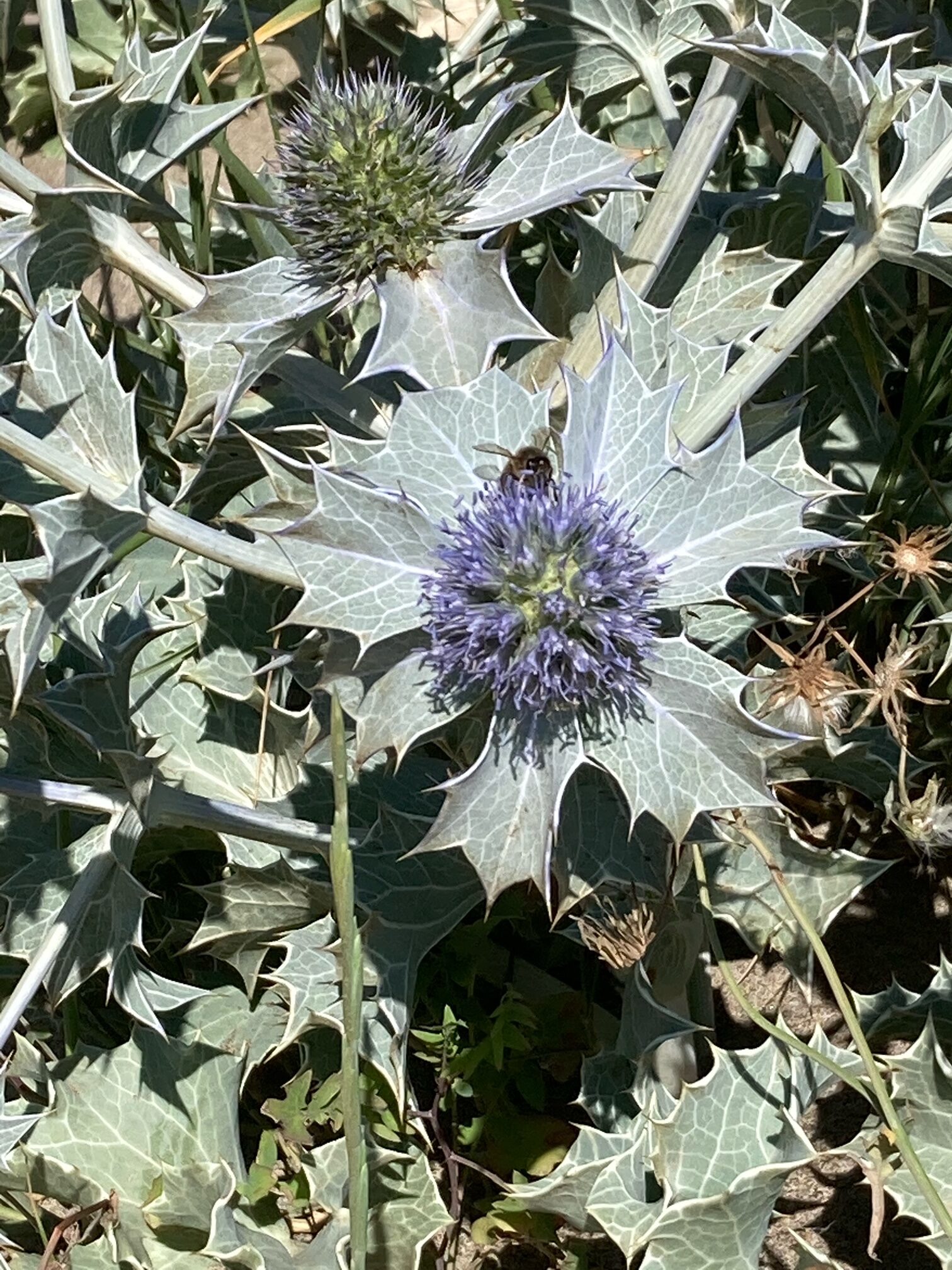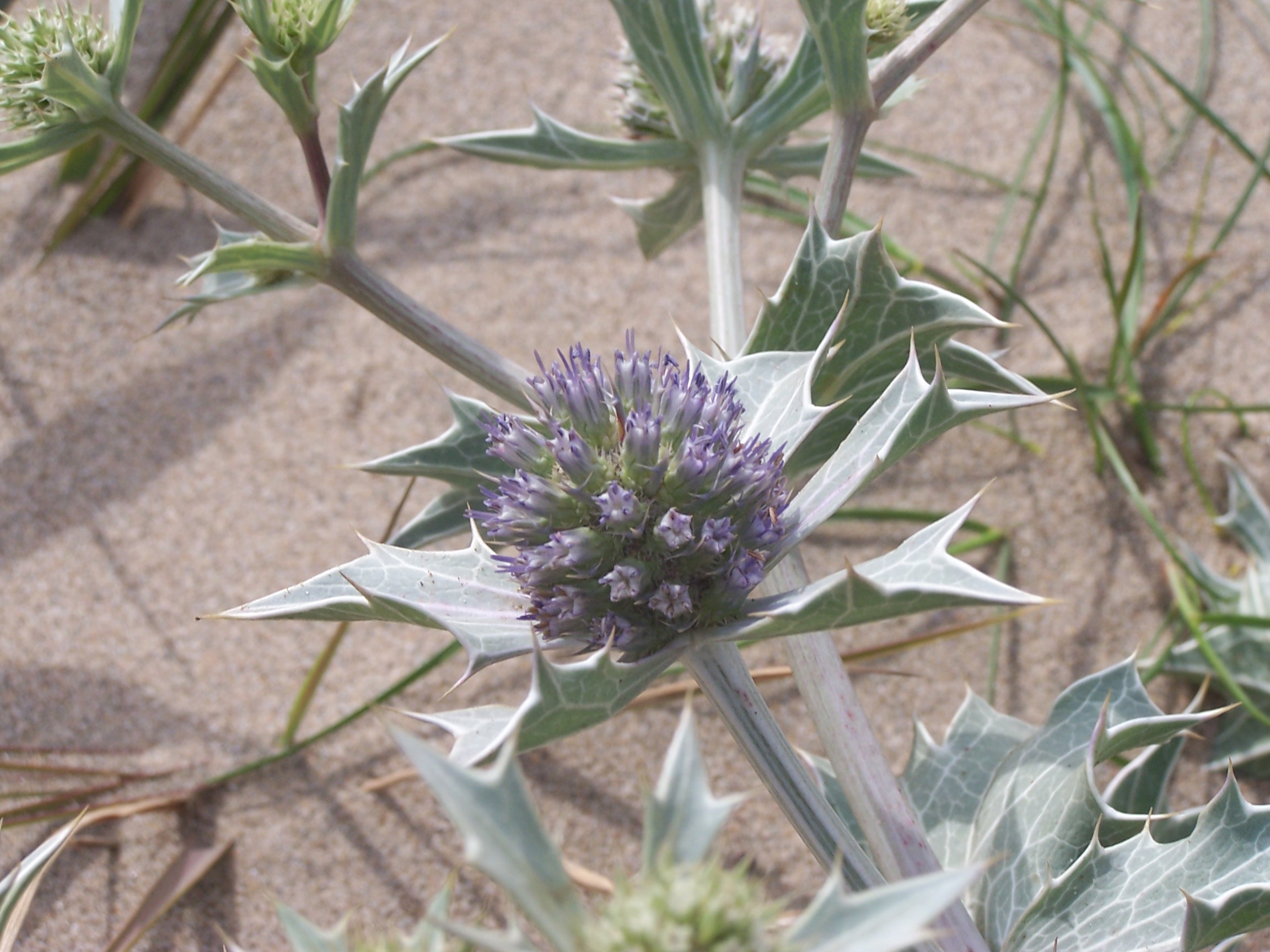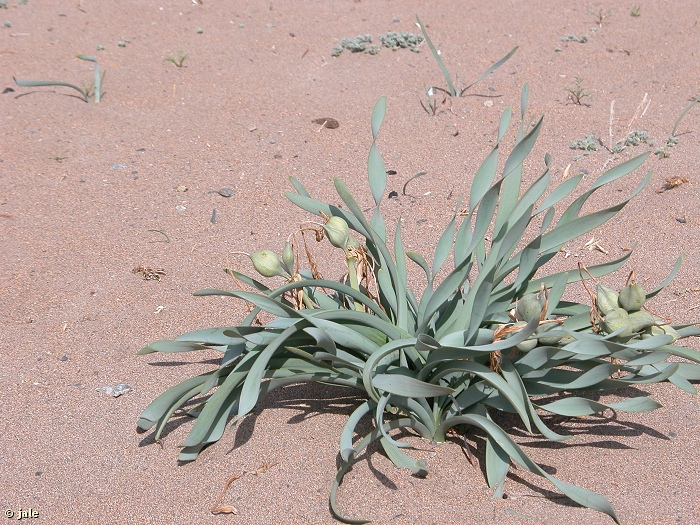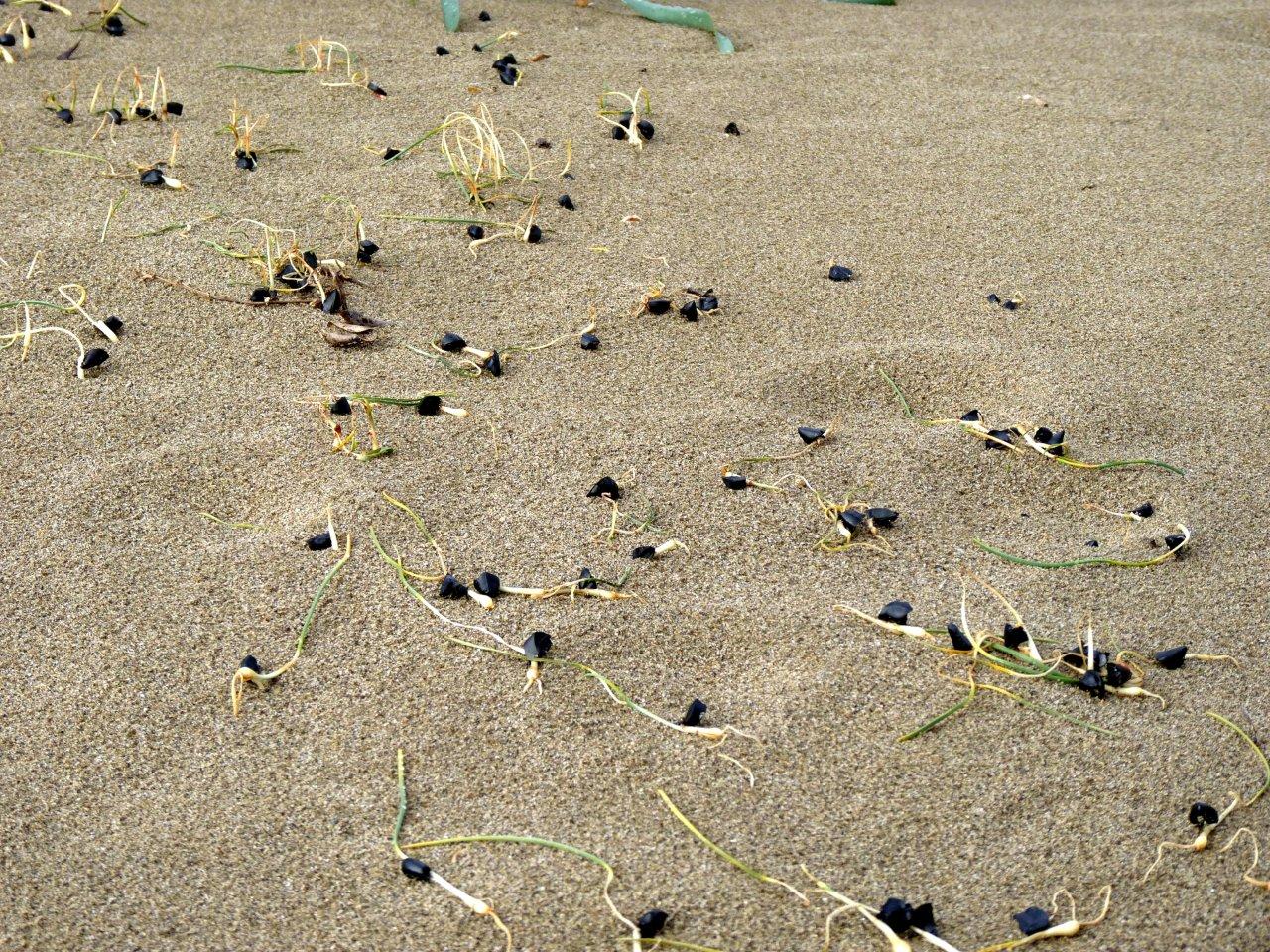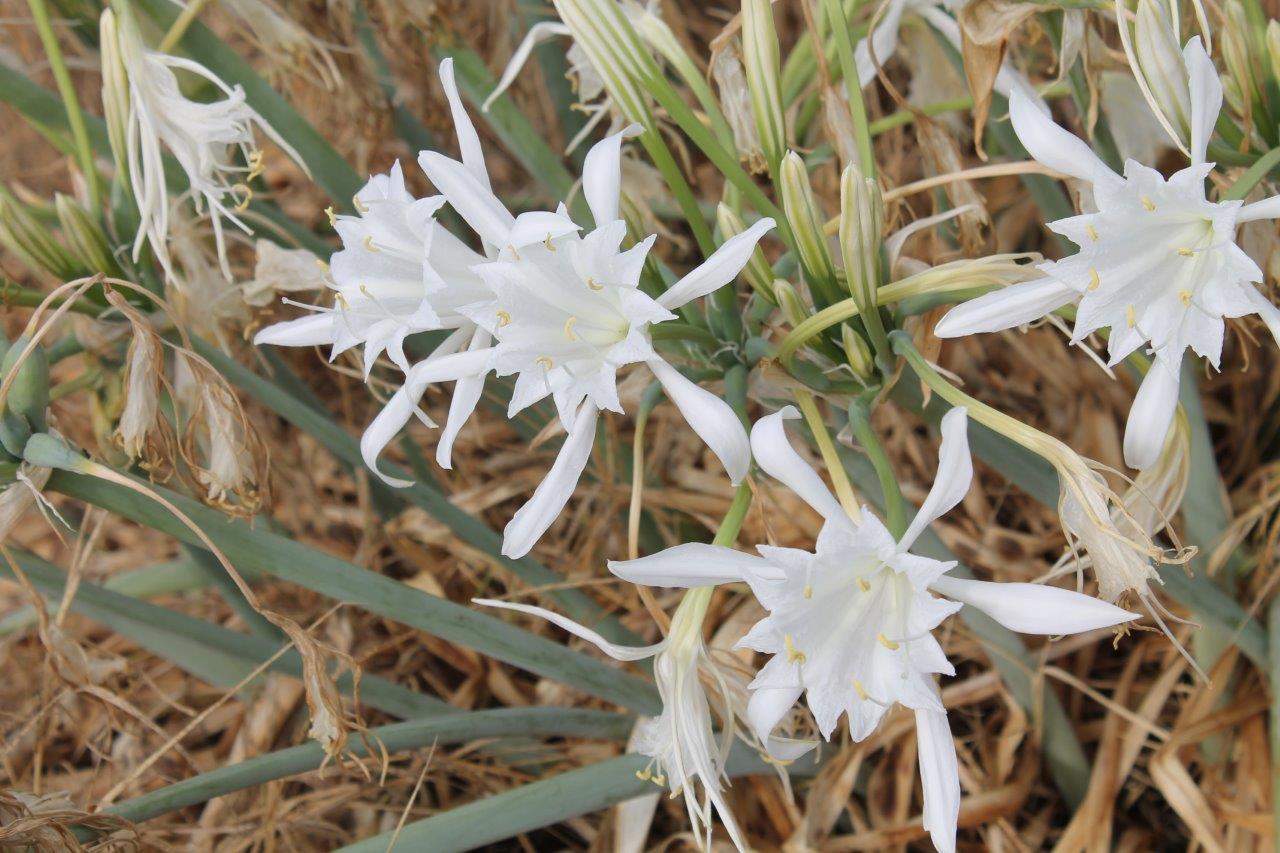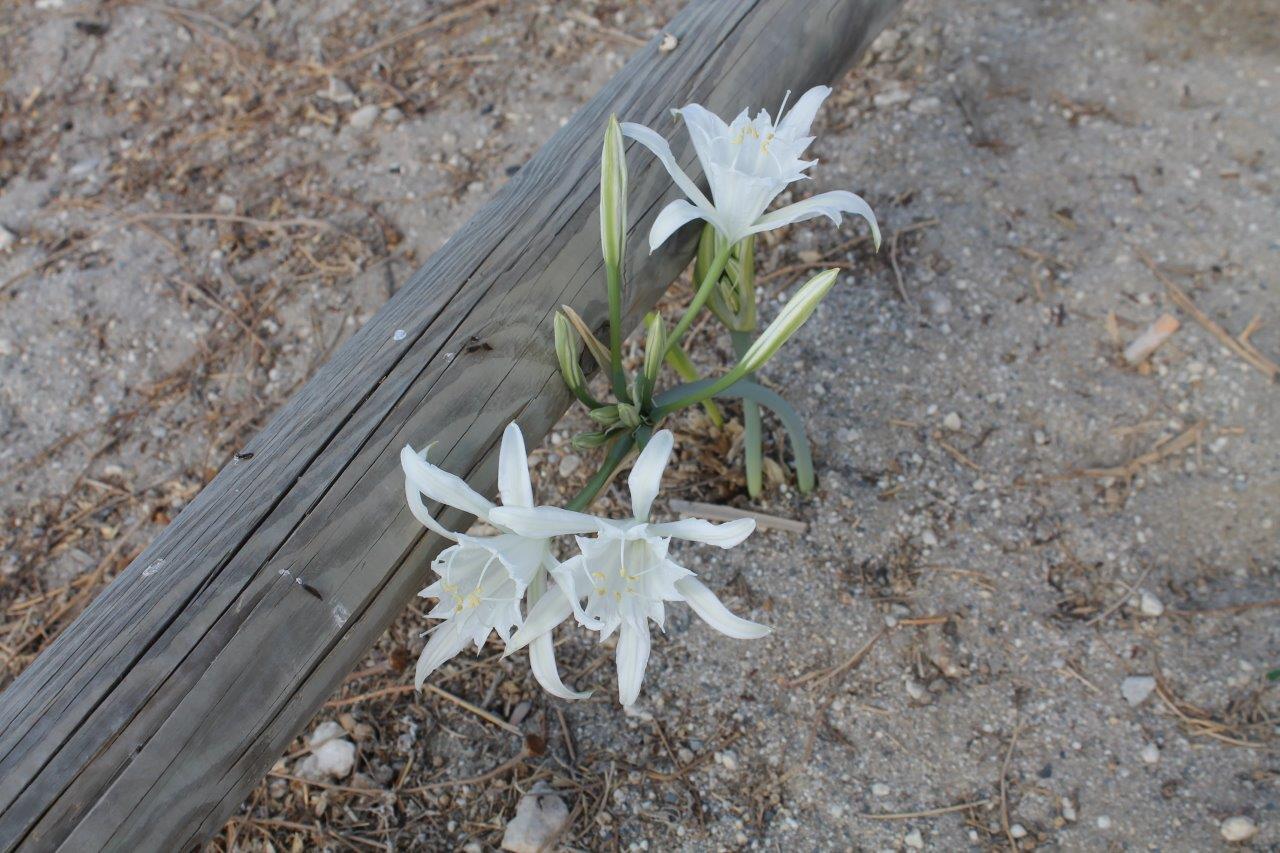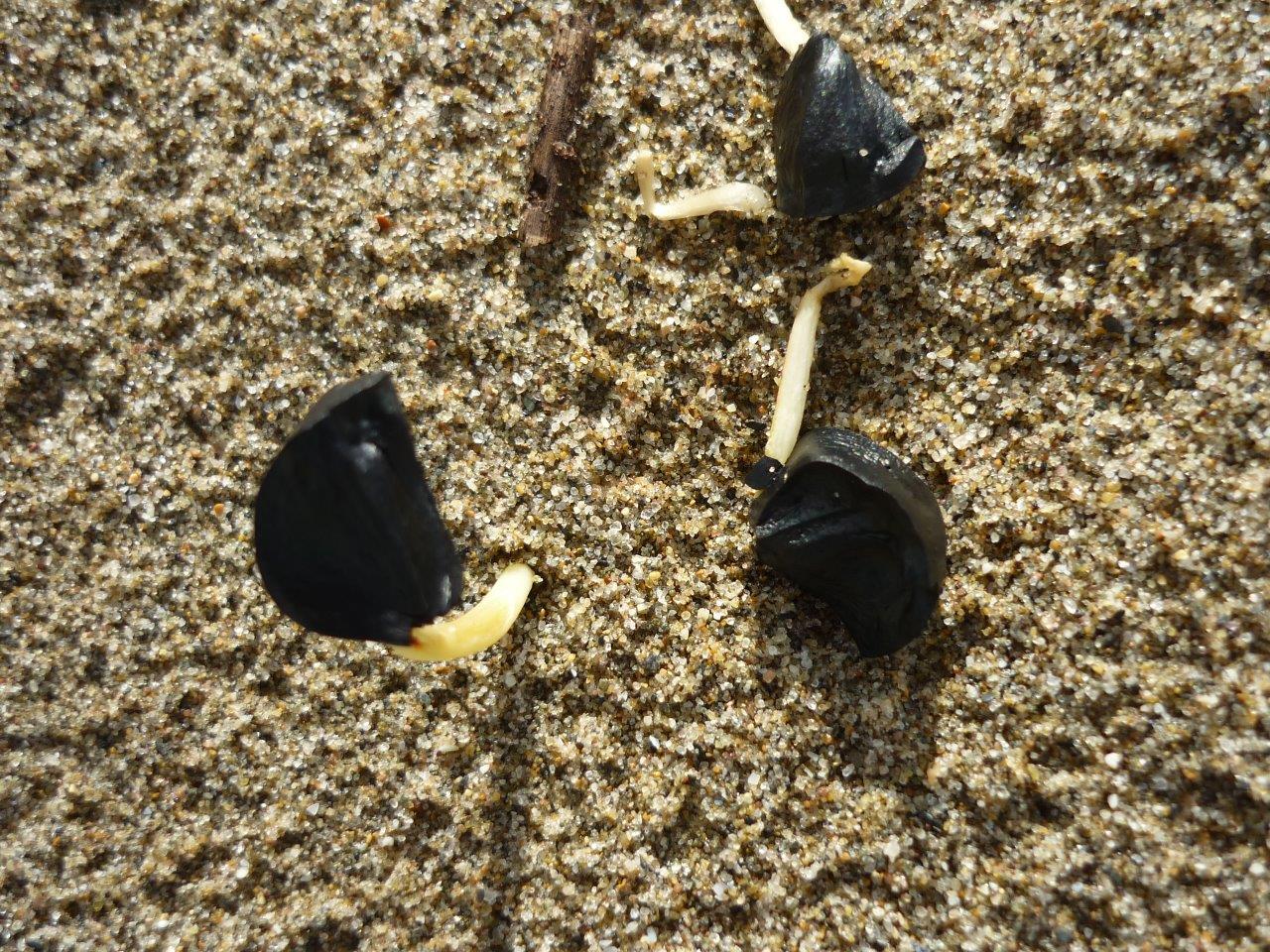ARTICLES AND CURIOSITIES
What is it that smells so good? A walk through the dunes of Artola
NOVEMBER 2022
New theme > Eryngium maritimum: The sea holly
It may be that you smell the sunscreen of the lady in front of you or the aftershave of the well-groomed gentleman who jogged past you. But I don’t mean these scents here, although they imitate the molecules of nature and of course put them in a completely different context. No, today I would like to write about another plant that is also native to the dunes of Artola, namely the sea holly (Eryngium maritimum), which is often called “die Stranddistel” in german and “panicaut de mer” in French. Incidentally, you can admire this not only in the Mediterranean, but also, for example, on the Shetland Islands, on the North and Baltic Sea coasts of Germany or on the shores of the Black Sea, because it is widespread. Their very hard leaves, which also have to withstand abrasive sandstorms, are covered with a bluish layer of wax – I have already introduced you to this class of chemical substances in connection with the sea lily (Pancratium maritimum). In both species, the wax acts as a seal to minimize water loss and as a sunscreen. Unfortunately, this plant is also often illegally dug up or picked and is considered highly endangered in large parts of its range. The sea holly blooms in summer and smells wonderful. What do you know about it? The scientific results so far have revealed some very interesting chemical compounds!
In fact, many research groups from all over the world have taken on the sea holly to identify the ingredients, mostly in search of new medicines from nature. For example, a French research group analyzed the essential oil of sea holly harvested in Corsica and Sardinia and found 63 different chemical compounds,1 three of which were previously completely unknown to the scientific world. However, the main component was germacrene D, which is also found in countless other natural places worldwide: e.g. in balsam tree plants (Burseraceae) in Central and South America and the Caribbean,2 which also includes the frankincense tree (Boswellia sacra)3 in Somalia, Oman and in Yemen, in Australian eucalyptus (Eucalyptus dunnii)4 and an angelica (Angelica glauca) found in Afghanistan, the Himalayas and Tibet,5 among many others. The smell of pure Germacren D is characterized by perfumers as woody, earthy, spicy, floral, soapy and green. Germacren D can also be found in basil or in chiroflakes, so at this point we can get a good idea of what this substance smells like.
Germacrene D belongs to the terpene class of compounds and has a fairly simple ten-membered ring structure of carbon and hydrogen. Its structural chemical formula is shown as molecule 1 in the attached scheme. You can recognize simple terpenes by the famous terpene dance step, which reads “one, two, methyl, three, four”. This is because terpenes are formally composed of the building block isoprene (molecule 2 in the diagram), which we also have in the air we breathe, for example. If you number the atoms of isoprene, knowing that the CH3 group means “methyl group” will get you exactly to the terpene dance step. Would you like to try dancing in the musically demanding five-four time with Germacren D? Start at the bottom right with the 1, the carbon atom next to it gets the number 2, and on that, before we get to the 3 and 4, there’s a methyl group. All natural compounds that you can number like this belong to the class of terpenes. Plants, insects and also animals including human beings usually produce these from activated acetic acid (“acetyl-CoA”) in order to obtain very complex structures via activated isoprene. As you read these lines, your body is busy with the synthesis of cholesterol and its hormones such as testosterone (even if you are a woman), which also belongs to the interesting class of terpenes.
Germacrenes are produced by plants to protect themselves against microbes and insect attack. However, it was also found that germacren D in particular acts on the neurons of the olfactory receptor in the antennae of some insects6 and is apparently perceived by them in the sense of a communication between plant and insect.
One of the new discoveries mentioned above in the essential oil of sea holly (Eryngium maritimum) is cadinenal 3 (see scheme), which also belongs to the class of terpenes. The smell of the parent compound, the cadinene, is characterized by perfumers as follows: fresh, woody, herbal, vetiver-like with notes of patchouli, spicy, phenolic with hints of chamomile. The aldehyde group of Cadinenal 3, newly discovered in 2014, should provide additional fresh and green notes in the smell. Cadines and cadinenals are also known as pheromones: Many insects have a caste system to distribute the work that needs to be done in the insect colony. The composition of these castes is determined by various factors such as pheromones produced by specific colony members. For example g-Cadinene und g-Cadinenal ensure that a colony of termites (Reticulitermes flavipes) produces soldiers who defend the colony.7 Both substances thus belong to caste-stimulating or caste-inhibiting primer pheromones and are a fantastic example of chemical communication in the natural kingdom.
According to an analysis from 2020, the roots of sea holly also contain large amounts of menthol and menthone.[8] Menthol is a so-called terpene alcohol found primarily in peppermint oil (Mentha piperita), but it also contributes to the aroma of the classic spice blend of Herbes de Provence with basil, marjoram, oregano, rosemary, sage and thyme, because it can be found in all these herbs.
So I would like to encourage you, dear readers, to take a stroll through the dunes of Artola with all your senses, absorb and enjoy the scents of the various plants, and do so in the knowledge that you are hearing the language of nature. And if, out of sheer excitement, you fall into the dance step of terpenes, all the better: one, two, methyl, three, four…….
Prof. Dr. Andreas Schmidt
Clausthal University of Technology
Institute of Organic Chemistry
Clausthal-Zellerfeld (Alemania)
[1] F. Darriet, S. Andreani, M.-C. De Cian, J. Costa, A. Muselli, Flavour Fragr. J. 2014, 29, 9 – 13.
[2] K. Noge, J. X. Becerra, Molecules 2009, 14, 5289 – 5297.
[3] A. Al. Harrasi, S. Al-Saidi, Molecules 2008, 13, 2181 – 2189.
[4] C. A. Zini, K. D. Zanin, E. Christensen, E. B. Caramão, J. Pawliszyn, J. Agric. Food Chem. 2003, 51, 2679 – 2686.
[5] V. K. Agnihotri, R. K. Thappa, B. Meena, B. K. Kapahi, R. K. Saxena, G. N. Qazi, S. G. Agarwal, Phytochemistry 2004, 65, 2411 – 2413.
[6] T. Røstelien, A.-K. Borg-Karlson, J. Fäldt, U. Jacobsson, H. Mustaparta, Chem. Senses 2000, 15, 141 – 148.
[7] M. R. Tarver, E. A. Schmelz, M. E. Scharf, J. Insect. Physiol. 2011, 57, 771 – 777.
[8] M. Kikowska, D. Kalemba, J. Dlugaszewska, B. Thiem, Plants 2020, 9(4), 417.
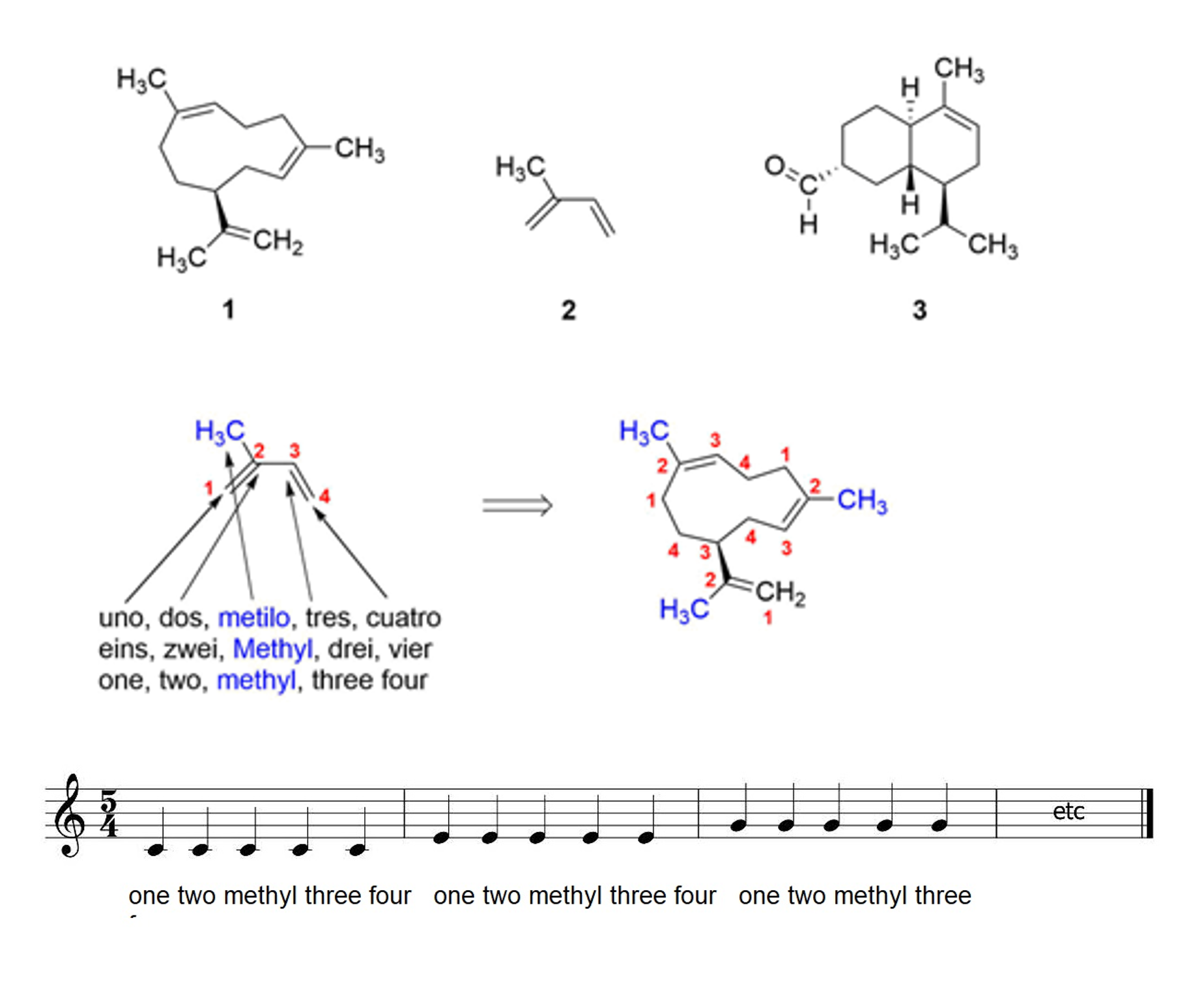
SEPTEMBER 2022
Part 1: Pancratium maritimum (The Sea Daffodil)
A bouquet of roses, the smell of a refreshing shower after a sunny summer day, a fresh sea breeze… who is not fascinated and excited by the multitude of fragrances that surround us in nature? They bring back memories, make us curious, make us breathe deeply, or when they are very strong, we walk around them to avoid them – and probably, reactions to smells are as diverse as the people who perceive them. Smells are the language of nature. They are caused by an interaction of chemical molecules with the receptors of the olfactory epithelium in our noses. They are communication tools between living things that have been tested effectively for a long time in evolution. The language of nature? You may wonder what a flowering plant wants to tell us? Well, this language is not directed at us, but at the plants that are growing nearby. Or at insects. Or at animals that share the plant’s habitat. These fragrances contain messages that serve to defend the plants, perhaps invite symbiosis, attract insects and – most likely – work as a vehicle for the exchange of information between species. Science is just beginning to dive into the secrets of this chemical language. But, what do we smell when we walk through the Artola Dunas? Could be it’s a Sea Daffodil which blooms in high summer. It can grow up to 60 cm tall, although its roots can go down to 140 cm into the sand! Even if it finds a suitable habitat in the dunes, the Sea Daffodil is unfortunately on the endangered species list [1], because it is picked by passers-by or inadvertently trampled on.
A few years ago, a group of researchers studied the fragrance repertoire of the Sea Daffodil (Pancratium maritimum), collecting fresh flowers from the Tunisian dune region and analysing their volatile chemical compounds [2]. The results: the flowers contain a large amount of hydrocarbons, which for example contain 28 carbon atoms and therefore can have a waxy consistency. These semi-firm biomaterials stabilise the plant against strong winds and abrasive sand grains, and protect the flower against drought, as well as against the dazzling sunlight on the dunes [3]. Along with these hydrocarbons, palmitic acid was also found, a component of fat, which can be found in animals, plants and humans. Its main function is energy storage. You may have heard of “Palmin”, you may even have it in your kitchen! Yes, the well-known frying fat gets its name from coconut oil, which contains palmitic acid. Why does the sea lily store palmitic acid in its petals? Well, hydrocarbons and palmitic acid help to defend plants against parasites [4]. However, the aforementioned components are also important for the chemical communication of plants, since they store as hydrophobic carriers the fragrances which the sea lily uses to contact other organisms in its environment. What does the sea lily want to say? And to whom? So far we don’t know. But according to the aforementioned study, the Sea Daffodil releases various scents that even we humans, with a relatively weak olfactory sense, can perceive. Within its aromatic repertoire there are mainly two esters and two alcohols. The first ester is benzyl benzoate. It is a substance with a wonderfully sweet and floral perfume, which is also produced by the cinnamon tree (Cinnamomum zeylanicum) and by other species of plants, which, together with other substances, constitute the perfume characteristic of blueberries. This ester has a disinfecting effect and in concentrated form can be used, for example, as a medicine against a mite infestation. Another fragrance from the petals of Pancratium maritimum is phenethyl alcohol, whose scent we know from hyacinths, carnations and geraniums. This molecule is also the main fragrance of rose oil which is why we recognise its perfume from countless perfumes and soaps. You probably know this fragrance also from a food we esteem highly: honey. An exercise for you: try to describe the aroma of honey. You will find that it reminds you of roses! By the way: this alcohol also has a disinfecting effect. Finally, we come to the third main component of the aromatic repertoire of the Sea Daffodil. It is the chemical compound (an ester) linalyl acetate, with a fresh and sweet smell. After what you have already read, it is surely no surprise that you realise you recognise this chemical compound, because linalyl acetate is the main aromatic component of lavender. Linalyl acetate is found in the south of France in large quantities by distilling the petals of lavender. Small amounts of farnesol, whose perfume is reminiscent of Lily of the Valley, complete the specific aromatic repertoire of the Sea Daffodil. Farnesol is a well-known pheromone among insects, and this is probably why it is produced by Pancratium maritimum. This compound attracts mosquito larvae [5] (Chironomidae) and honey bees (Apis mellifera L.) [6] and is used by male bumblebees (Bombus sp .; Psithyrus sp.) [7] as a signalling odour. In total, the group of researchers managed to identify 18 different substances in the petals that contribute to the flower’s perfume.
There are still many things about the Sea Daffodil to be investigated, because it contains many substances that do not have any odour as they are not volatile. Within this category are alkaloids, which can be found in the roots or petals of Pancratium maritimum. Alkaloids not only possess complicated and interesting structures, but also show positive reactions in the fight against various diseases such as cancer or infectious diseases. This is a subject which the author of these lines would like to tell you about on another occasion. For now, I would like to close this reference with a comment: the Sea Daffodil, like all plants, is a wonder of nature, full of interesting molecules, but still full of secrets regarding its relationship to their communication with neighbouring plants, insects and other animals living in the dunes.
Prof. Dr. Andreas Schmidt
Clausthal University of Technology
Institute of Organic Chemistry
Clausthal-Zellerfeld (Alemania)
[1] H. Zahreddine, C. Clubbe, R. Baalbaki, A. Ghalayini, S. N. Talhouk, Biol. Conserv. 2004, 120, 11 – 18.
[2] A. Sanaa, A. Boulila, A. Bejaoui, M. Boussaid, N. B. Fadhel, Ind. Crops Prod. 2012, 40, 312 – 317.
[3] R. Jetter, L. Kunst, A. L. Samuel, in: M. Riederer, C. Müller, (Eds.), Biology of the Plant Cuticle. Blackwell Publishing, Oxford, 2006, 145 – 181.
[4] K. Alipieva, L. Evstatieva, N. Handjieva, S. Popov, Z. Naturforsch. C 2003, 58, 779 – 782.
[5] D. G. Naik, A. A. Babrekar, B. B. Nath, Chem. Ecol. 2006, 22, 501 – 508.
[6] I. H. Williams, J. A. Pickett, A. P. Martin, J. Chem. Ecol. 1981, 7, 225 – 237.
[7] B. Kullenberg, G. Bergstrom, B. Bringer, B. Carlberg, B. Cederberg, Zoon 1973, Suppl. 1, 23 – 2
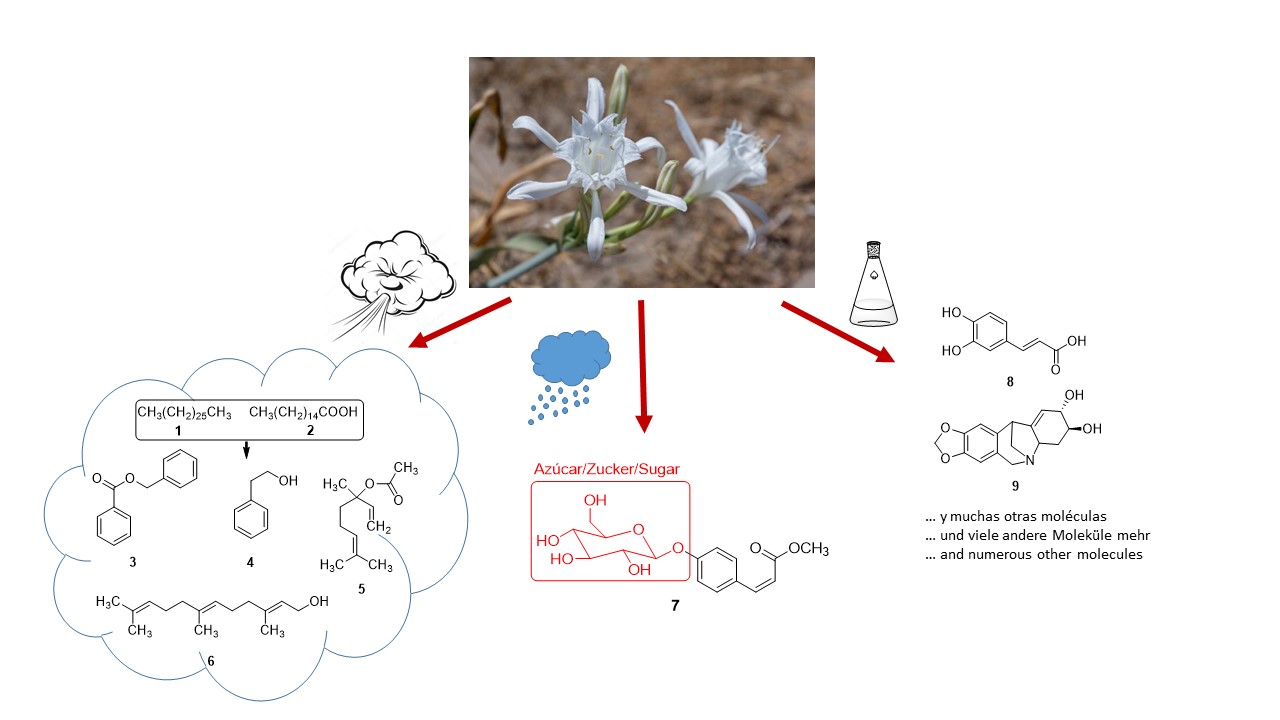
Part 2: Pancratium maritimum: Some more mysteries….
Nature is fascinating, both in its large and in its small scales: the functioning of an entire ecosystem is also based on the chemical communication of the various species, which differ in terms of habitat, access to water and food, exposure to light, protection from predators or from mechanical, biological or chemical weathering. However, things are not always peaceful. Some plants, such as the walnut tree, spread natural herbicides to keep their own growing site clear of other plants. Have you ever noticed that almost nothing grows under walnut trees? This is because the walnut tree does not want this and uses chemical defenses to defend itself. But the communication between the species is usually much more delicate than in this example and often serves to establish and maintain complex symbioses. Much research is only possible through the development of highly efficient analytical methods in the natural sciences, so that the chemical basis of what biology has observed can be understood. Dealing with molecules synthesized by different species and used for chemical communication means to feel the whole fascination of an ecosystem from the beauty of an intact landscape down to the level of the chemical compounds involved. In part 1 of this small series, I reported to you about the enchanting scented bouquet of the flowers of the Sea Daffodil (Pancratium maritimum). Experienced by anyone who has walked the Artola Dunes, the Sea Daffodil gives off a delightful scent when in bloom. This fragrance is composed of various molecules that are dissolved in long-chain, water-insoluble hydrocarbons such as heptacosane 1 and the fatty acid palmitic acid 2 and thus continuously released with the wind.1 The actual fragrance of the Sea Daffodil then has four main components, which are shown in the attached scheme: Benzoic acid benzyl ester 3, 2-phenylethanol 4, linalyl acetate 5, and farnesol 6. There is also a number of other components, all of which should also be well known to perfumers. An Arab group of researchers has now been able to obtain other interesting molecules from the flowers, all of which are cytotoxic and which were described this year (2022).2 These include so-called glycosides such as 7, which contain a sugar molecule such as glucose and are therefore water-soluble. Such molecules are washed off the plant when it rains or with the dew and thus get into the soil, where the glucose is broken down by microorganisms as food, but not the rest of the molecule at first. This then develops a biological effect in the soil. This is also the case with the aforementioned walnut tree, which wants to defend its place. It also uses microorganisms with which it lives in symbiosis for its communication. The biological role played by molecule 7 in Pancratium maritimum must remain a matter of speculation at this point. But I’m pretty sure that there’s a kind of communication going on here that we don’t yet understand. In addition to a number of other molecules, the Arab research group also found caffeic acid 8 in the flowers, which coffee contains in large quantities, namely between 25 and 75 mg per cup. Related structures are also found in the bulbs of the plant.3 Now, chemically speaking, the Sea Daffodil´s bulb is even more interesting than the flowers, being a source of other complicated structures from the alkaloid kingdom, many of which have medicinal properties. Various researchers from Bulgaria4 and Turkey5, who should be mentioned here as examples for many other research groups, were able to isolate dozens of different alkaloids, i.e. nitrogen-containing molecules, from the bulbs. Of these, molecule 9 even bears a name derived from the name of the plant considered here: pancracine. This member of the group of pancratium alkaloids,6 which is also found in other plants, is of interest for the therapy of cancer diseases.7 The Sea Daffodil is a source of inspiration for various scientific studies and whole books could be written about it. The previous research results in the field of chemistry of this plant alone are summarized in almost 120 publications, in addition to numerous reports from pharmacology, medicine and biology. Therefore, the sea lily deserves full protection not only for its role in the ecosystem, for example in the Artola dunes, and for its extreme beauty and elegance, but also because from a chemical point of view it is a marvel of nature and still full of mysteries
Prof. Dr. Andreas Schmidt
Clausthal University of Technology
Institute of Organic Chemistry
Clausthal-Zellerfeld (Alemania)
[1] A. Sanaa, A. Boulila, A. Bejaoui, M. Boussaid, N. B. Fadhel, Ind. Crops Prod. 2012, 40, 312 – 317.
[2] D. T. A. Youssef, L. A. Shaala, A. E. Altyar, Plants 2022, 11, 476.
[3] D. T. A. Youssef, M. A. Ramadan, A. A. Khalifa, Phytochemistry 1998, 49, 2579 – 2583.
[4] S. Berkov, L. Evstatieva, S. Popov, Z. Naturforsch. 2004, 59c, 65 – 69.
[5] B. Bozkurt, G. I. Kaya, N. U. Somer, Nat. Prod. Commun. 2019, 14 (10), 1 – 4.
[6] J. C. Cedrón, M. Del Arco-Aguilar, A. Estévez-Braun, Á. G. Ravelo, in: The Alkaloids: Chemistry and Biology 2010, 68, 1 – 37.
[7] D. Koutová, R. Havelek, E. Peterová, D. Muthná, K. Královec, K. Breiterová, L. Cahliková, M. Rezácová, Int. J. Mol. Sci. 2021, 22(13), 7014.
Do you want to receive our Newsletter?
Do you want to become a member or be our friend of the dunes?
Asociación ProDunas Marbella
The Association works tirelessly for the defence and preservation of the unique ecosystems that survive in the natural sand dune environments in the Province of Málaga; promotes the protection of native flora and small wildlife; promotes recovery, rehabilitation and conservation of interesting biodiversity of sand dunes areas in the municipality of Marbella.


